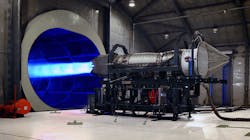Pratt & Whitney Proceeding with Adaptive Engines Research
Pratt & Whitney drew a $437-million contract modification from the U.S. Air Force to implement “next-generation adaptive propulsion risk reduction, for potential air superiority applications.” The contract is similar to one placed with GE Aviation in June, toward defining design objectives for a combat aircraft that will follow the current F-22 fighter, built by Lockheed Martin and powered by the Pratt & Whitney F-119 turbofan engine.
The USAF has assigned Pratt & Whitney to develop a demand-modulated engine architecture, and to advance an adaptive technology suite, including control, power, and thermal management systems to achieve more range, persistence, survivability, and maintainability for advanced weapon systems.
In addition to advancing existing engine technology, Pratt & Whitney is incorporating its results from design work and test completed as part of the Adaptive Engine Technology Development (AETD) effort, to ensure that the Adaptive Engine Transition Program (AETP) refines the technologies for future mission requirements.
"We look forward to continuing the maturation of adaptive engine technologies in collaboration with the U.S. Air Force for the next generation of combat aircraft," said Chris Flynn, Vice President of Military Development Programs at Pratt & Whitney. "In addition to providing a seamless transition between high thrust and fuel efficiency, adaptive propulsion can enable an unprecedented range of capability growth in mission systems and heat dissipation capacity at the air vehicle level. We are committed to giving the warfighter a technological advantage."
